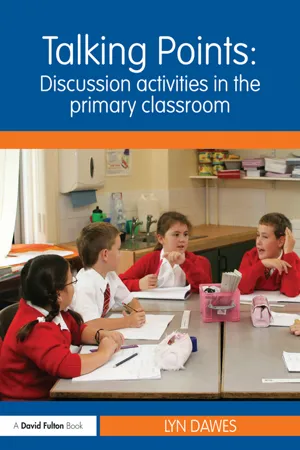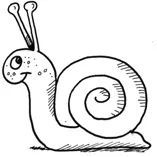
Talking Points: Discussion Activities in the Primary Classroom
Lyn Dawes
- 136 páginas
- English
- ePUB (apto para móviles)
- Disponible en iOS y Android
Talking Points: Discussion Activities in the Primary Classroom
Lyn Dawes
Información del libro
Talking Points: Discussion Activities in the Primary Classroom encourages and supports classroom discussion on a range of topics, enabling children to develop the important life-skill of effective group communication. Children who can explain their own ideas and take account of the points of view and reasons of others are in the process of becoming truly educated. This book offers a straightforward way of teaching children discussion skills within the framework of a creative curriculum.
The book provides an introduction on how to help children learn the skills of group discussion, offering six essential Talk Lessons to use in the classroom, alongside suggestions on how teachers can plan their lessons with a talk focus, set learning outcomes and create their own Talking Points to suit topics they are teaching. The main body of the book contains the Talking Points resources which are an excellent, tried and tested way of stimulating and supporting extended talk about a topic. The Talking Points in this book offer model for teachers to create further Talking Points for their own classes. The Talking Points included here offer discussion in several curriculum areas including: -
-
- Science
-
- Literacy
-
- Philosophy and creativity for children
-
- History
-
- Mathematics
-
- Art and Music
This invaluable book offers engaging, stimulating and thought provoking ideas for children to pit their wits against, promoting skills in discussion, analysis, reasoning and interaction. It is highly beneficial reading for teachers working in Key Stage 2, head teachers and those responsible for staff development, as well as students on teacher training courses and graduate training programmes.
Preguntas frecuentes
Información
| Talking Points for Science |





- All creepy crawlies are insects.
- Insects all eat plants.
- Spiders and insects are the same thing.
- Woodlice have live babies; they do not lay eggs.
- The woodlouse has a hard outside shell.
- The woodlouse has more legs than a spider.
- Woodlice move at different speeds.
- Woodlice have more in common with lobsters than with spiders.
- Snails are both male and female.
- Slugs are snails that are in between one shell and the next size up.
- There is more than one sort of worm.
- Ladybirds lay eggs and tiny ladybirds hatch out in summer.
- Insects have six legs, so a caterpillar is not an insect.
- Butterflies have scales on their wings.
- Moths find their way by using light and scent.
- Beetles all have hard wing cases.
- Dragonflies are carnivores.
- Composting is helped by worms.
- In Victorian times, there were 100 times more butterflies than now.
- Some insects use camouflage to protect themselves.


- Micro-organisms are the same thing as germs.
- There are germs all around us.
- We always get ill when we catch a germ.
- We can explain exactly what a virus is (practise trying!).
- A bacteria and a virus are the same thing.
- You can only catch germs through the air.
- There is nothing you can do to stop germs spreading.
- We don’t have any germs!
- An...